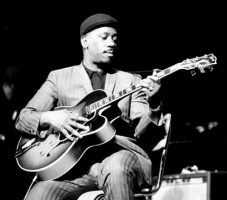Wes Montgomery | Jazz Master Guitarist and Band Leader

Wes Montgomery is considered by many as the greatest jazz guitarist of all time. And to some, the greatest jazz musician to ever take the bandstand. Wes's inability to read music and poor knowledge of written music theory, placed him in a league of his own, as one of the few musicians in jazz history that was able to play purely from the feeling and harmonic direction of a tune, without ever having to be troubled with over-thinking the technicalities behind the music. When you listen to Wes Montgomery play, his poetic charm and ability to restrain and explode at the appropriate moments, gives you a feeling of true narrative that few jazz players are able to master.
Wes Montgomery's use of octaves became a trademark of his playing, effortlessly gliding through the changes with his thumb-striking technique. Although he was know for his octave playing, it is often mistaken that he pioneered the technique, which was in fact used often by Django Reinhardt before Montgomery's adaptation.
It took Wes a awhile to acheive success. He began teaching himself guitar using his thumb in 1943. His first break was a set of tours with Lionel Hampton through 1948-1950. When Montgomery returned to Indianapolis after traveling with Lionel, he remained an obscure figure in jazz through much of the 1950s. He worked a day job and played at area clubs at night. Wes began recording with his brothers, vibraphonist Buddy, and electric bassist Monk, through 1957-1959. His first Riverside album Fingerpickin' (1958), was recorded in a trio with organist Melvin Rhyne.
Two years later, his 1960 release The Incredible Jazz Guitar of Wes Montgomery made him immediately famous in the world of jazz. He began playing with greats such as John Coltrane, Eric Dolphy, and others. Soon, Wes adapted easily to the role of band leader, and remained so for the rest of his career.
His Riverside recordings are probably his greatest and most spontaneous examples of his masterful playing (1959-1963). The small-group sessions with great sidemen like Tommy Flanagan, Victor Feldman, Hank Jones, James Clay, and Johnny Griffin, are second-to-none in jazz history. Luckily, all of the Riverside recordings have been reissued in a major expansive 12-CD box set. After Riverside fell apart, Montgomery made the transition to Verve, and remained on the label from 1964-1966. These recordings include an interesting series of orchestral moments with arranger Don Sebesky and producer Creed Taylor. These albums were crafted as more accessible jazz records, but the best performances were still the small-group outings with either the Wynton Kelly Trio or Jimmy Smith. In Wes's final period before his death in 1968 of a sudden heart attack in his Indianapolis home, he signed with Creed Taylor at A&M. Wes recorded three best-selling albums that were far more pop-oriented than his early material. He was backed by strings and woodwinds with mainstream simple pop-melodies - his jazz fans were understandably upset with the shift in style, but for the first time Montgomery's albums were played steadily on AM radio.
What Wes did in this period though, is help introduce a wider audence of listeners to jazz. His live performances were atill as freewheeling as his earlier Riverside dates, which brought even more positive attention to the genre once people were eased into jazz with a more accessable introduction. Montgomery's influence is still felt all over the jazz community, as he is reverered as one of the great spontaneous musical poets of all time.






